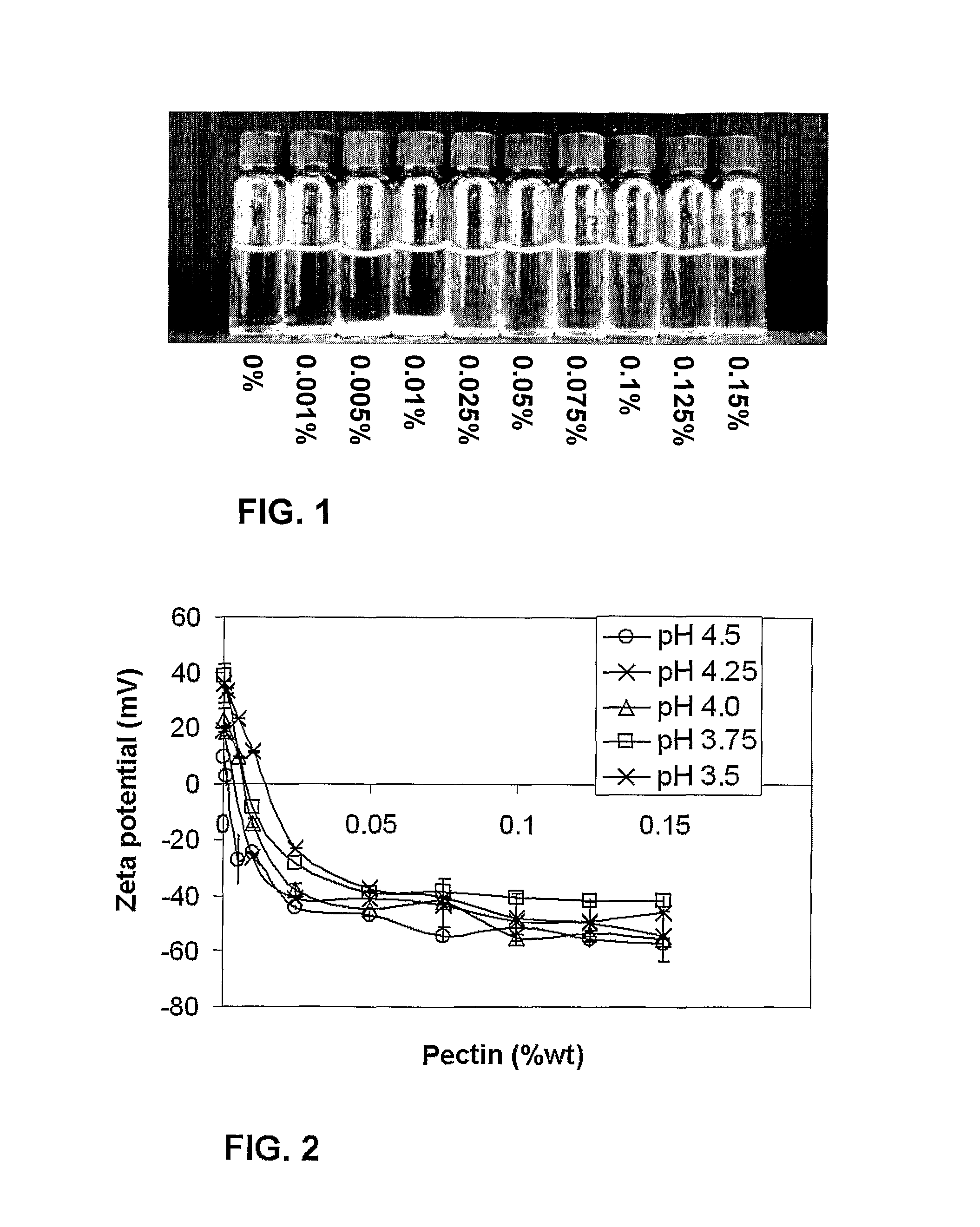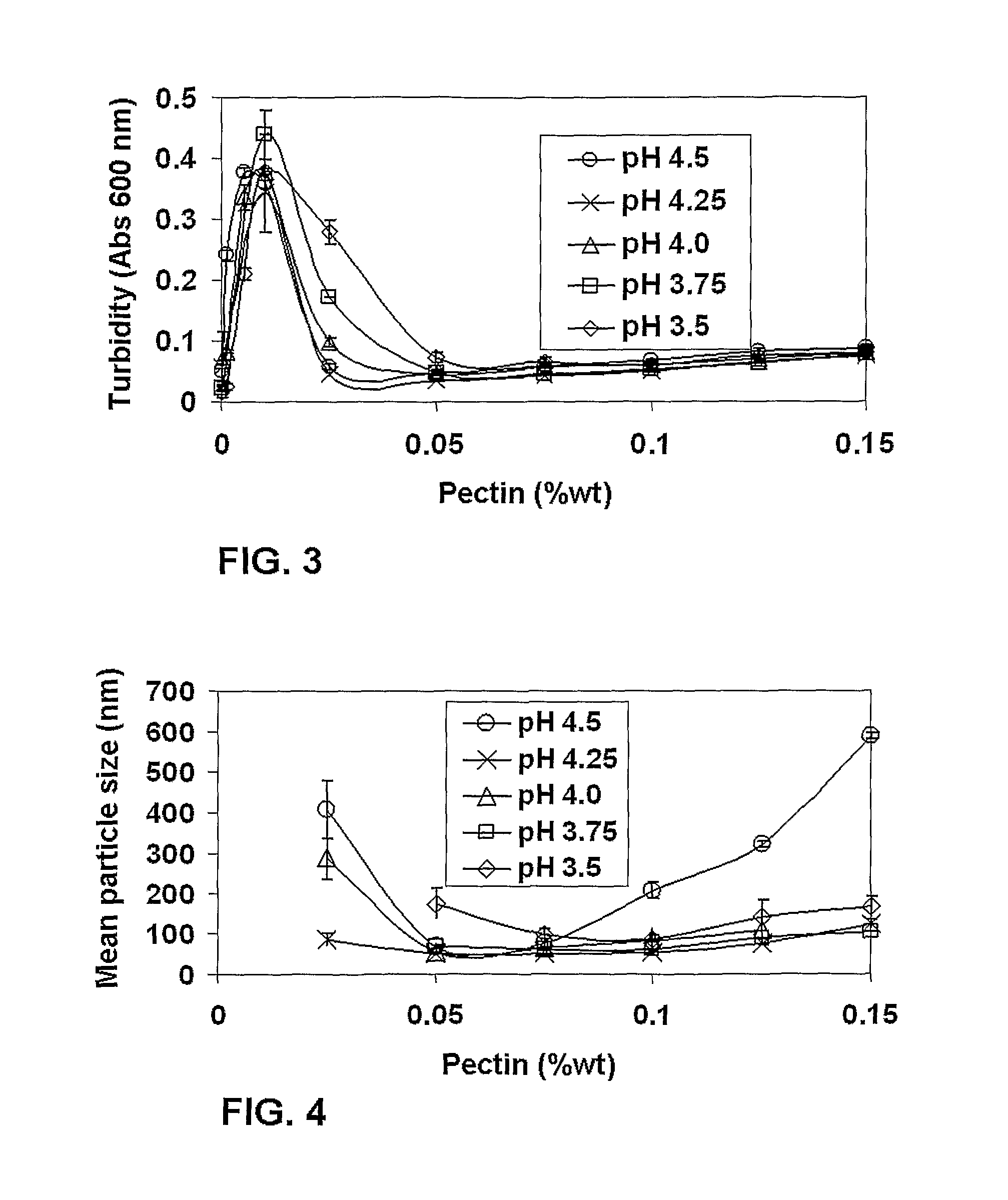Beta-lactoglobulin-polysaccharide nanoparticles for hydrophobic bioactive compounds
a bioactive compound, betalactoglobulin technology, applied in the field of lactoglobulinpolysaccharide nanoparticles, can solve the problems of difficult to provide the required amount of essential difficult to ensure the purity of clear beverages, and difficulty in providing hydrophobic biologically active compounds that are easily degraded during processing, etc., to achieve the effect of not compromising the transparency of clear beverages and the appearan
- Summary
- Abstract
- Description
- Claims
- Application Information
AI Technical Summary
Benefits of technology
Problems solved by technology
Method used
Image
Examples
example 1
β-Lactoglobulin-Pectin Electrostatic Complex Formation
[0125]A series of solutions containing a constant protein concentration (0.05% wt) and varying pectin concentrations (0-0.15% wt) were prepared by adding different amounts of 0.2% wt stock polysaccharide solution to the protein solution. These solutions were titrated to the desired pH, using HCl, than stirred for 1 hr and stored overnight at room temperature prior to analysis.
[0126]FIG. 1 shows the visual sedimentation observation results, 24 hrs after mixing the biopolymer solutions and slowly adjusting the pH to 4.0 while stirring. β-lactoglobulin concentration was 0.05%. The results of the ratio scan at pH 4.0 indicated that when β-lactoglobulin concentration was kept constant at 0.05% wt, the pectin percentage range that provided the desired properties of transparency and stability was above 0.025% wt pectin (FIG. 1-3). As pectin concentration was increased from 0.001 to 0.01% wt, more and more coacervation occurred (i.e. neu...
example 2
The Effect of pH on Particle Size and Turbidity of β-Lactoglobulin-Pectin Complexes
[0127]The effect of pH on particle size and turbidity was studied in the range 3.5≦pH≦4.5. Pectin concentrations were maintained within the range used in Example 1. FIG. 3 shows the influence of pectin concentration on turbidity of 0.05 wt β-lactoglobulin solution at the studied pH range. The effect of pH on turbidity was most notable between 0.001 and 0.05% wt pectin. In this range, as the pH increased from 3.5 to 4.25 the turbidity decreased. FIG. 4 shows that for most pH values, size was minimal between 0.05% and 0.075% pectin. Table 1 shows the minimal mean particle size of the β-lactoglobulin-pectin complexes at the different pH studied and the pectin concentration at these minima. The smallest mean particle size, 49 nm, was obtained at pH 4.25, and 0.075% wt pectin. Interestingly, at pH 4.5, closest to the pI of the protein, particle size was most strongly dependent on pectin concentration. When...
example 3
Encapsulation of Vitamin D2 in β-Lactoglobulin-Pectin Complexes and Effect on Particle Size
[0129]Incorporation of vitamin D2, as an exemplary fat-soluble vitamin, into β-lactoglobulin-pectin complexes necessitated binding vitamin D2 to β-lactoglobulin prior to pectin addition. The vitamin was dissolved in absolute ethanol. A 276 μL aliquot of a 5 mg mL−1 solution of vitamin D2 in absolute ethanol was added, while stirring, to 100 mL of 0.2% wt β-lactoglobulin solution at pH≈6.8, then stirred further for 30 minutes. Pectin solution was then added to the β-lactoglobulin-vitamin D2 solution to final concentrations of 0.05% wt protein and 0.1% wt pectin, and the pH was adjusted to 4.0. The samples were stirred further for an hour. FIG. 6 shows the particle size distributions of: 0.05% wt β-Lg only; vitamin D (0.027 mM) only; complexes made with 0.05% wt β-Lg, 0.05% wt pectin and vitamin D (0.027 mM) and complexes of 0.05% wt β-Lg and pectin 0.05% wt (without the vitamin). All of the sys...
PUM
| Property | Measurement | Unit |
|---|---|---|
| diameter | aaaaa | aaaaa |
| diameter | aaaaa | aaaaa |
| diameter | aaaaa | aaaaa |
Abstract
Description
Claims
Application Information
 Login to View More
Login to View More - R&D
- Intellectual Property
- Life Sciences
- Materials
- Tech Scout
- Unparalleled Data Quality
- Higher Quality Content
- 60% Fewer Hallucinations
Browse by: Latest US Patents, China's latest patents, Technical Efficacy Thesaurus, Application Domain, Technology Topic, Popular Technical Reports.
© 2025 PatSnap. All rights reserved.Legal|Privacy policy|Modern Slavery Act Transparency Statement|Sitemap|About US| Contact US: help@patsnap.com



